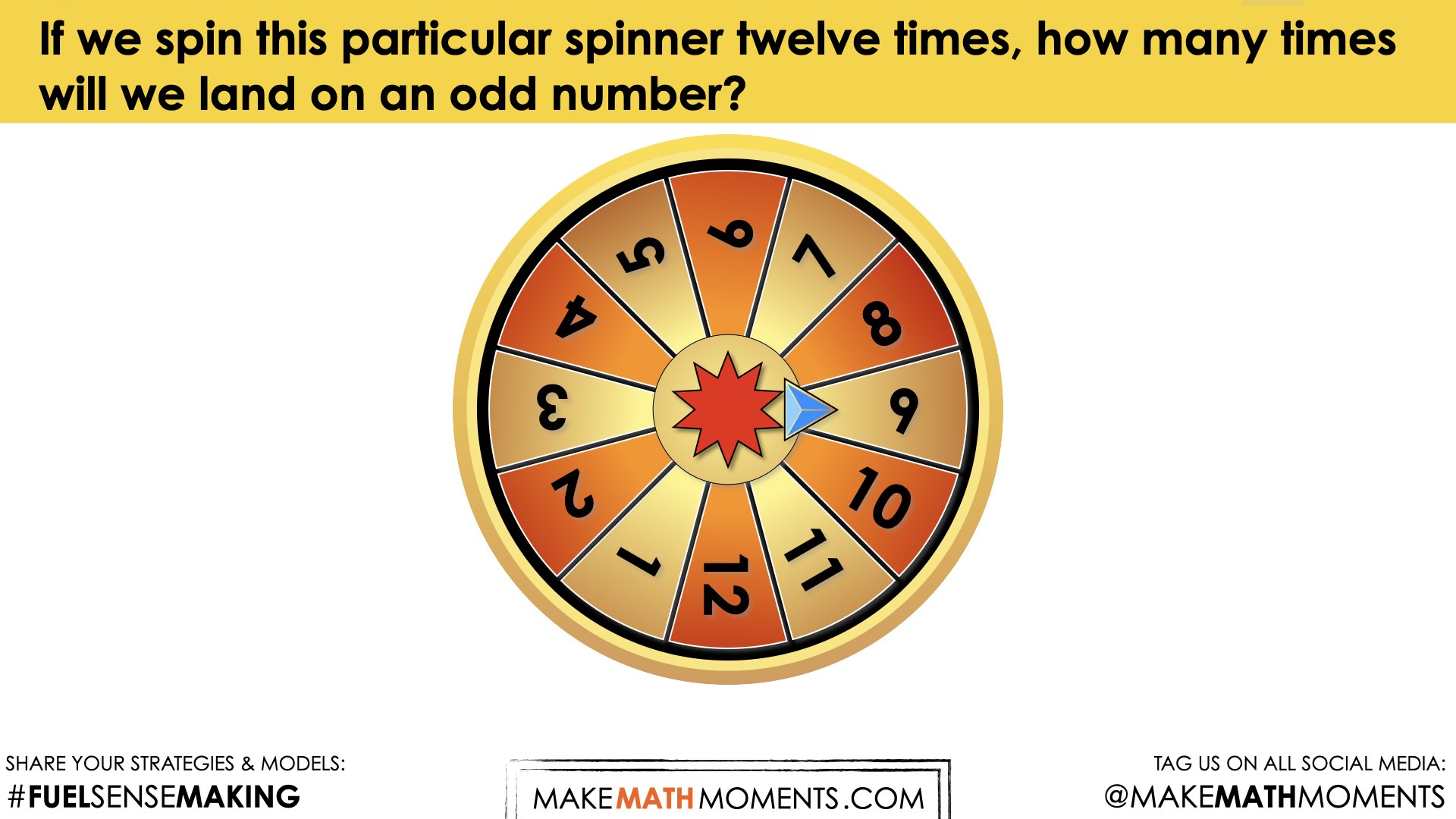TAKE A CHANCE [DAY 3]
PROBABILITY OF A CHANCE EVENT
Express the probability of a chance event.
Intentionality
Spark Curiosity
Fuel Sensemaking
During Moves
Next Moves
Consolidation
Reflect and Consolidation Prompts
Resources & Downloads
Educator Discussion Area
Intentionality & Unit Overview
![Take a Chance [Day 1] | Data: Probability 3 Act Math Task](https://learn.makemathmoments.com/wp-content/uploads/2024/03/MMM-Task-Take-a-Chance-Featured-Image.png)
Length of Unit: 5 Days
Access each lesson from this unit using the navigation links below
Students will determine and compare the spinner’s theoretical and experimental probabilities.
Learning goals:
- We will describe the likeliness of an event or outcome.
- We will use fractions to express the probability of a chance event.
- We will represent the probability on a 0 to 1 number line.
- We will determine and compare a chance event’s theoretical and experimental probabilities.
Intentionality…
In this task, students will explore and compare theoretical and experimental probability by conducting trials. Leveraging the context from day 1 of the spinner, students will predict the outcome based on the theoretical probability and then conduct trials. Big ideas that may emerge in today’s lesson include:
- The theoretical probability of a chance event can be used to predict the likeliness of that event.
- The more trials done in an experiment, the closer the experimental probability will be to the theoretical probability.
Spark Curiosity
What Do You Notice? What Do You Wonder?
Show students the following video:
Then, ask students:
If we spin this particular spinner twelve times, how many times will we land on an odd number?

Give students 30 seconds (or more) of think time.
Then, ask students to share with their neighbours for another 30 seconds.
Engage in a brief group discussion about the theoretical probability of this particular event.
Sample response:
Because six of the 12 parts are odd numbers, we predict we will land on an odd number half the time. Six of the spins will land on an odd number.
Share the following video to test this theory. Alternatively, you can pull up any digital spinner with twelve equal parts.
Ask students to record the results of this experiment.
Estimation: Prompt

After viewing the video or testing this probability with your spinner, compare the results to your initial prediction. Did the spinner land on an odd number six times, half the spins? What could we do to get closer to half the spins? Perhaps spin some more?
Fuel Sense-making
Crafting A Productive Struggle: Prompt
Theoretical probability is a calculation that helps us predict the likeliness of a chance event. Experimental probability is the results gathered from running many trials of an experiment.
Let’s focus on our twelve-part spinner.
Student Prompt:
Make a prediction:
If we spin the spinner 36 times, how many times will we land on a multiple of three?
Experiment:
Spin your spinner 36 times, and record the results.
How did your experiment compare to your prediction?

Facilitator note: Students can create a paper spinner using the linked PDF, a pencil, and a paperclip. Alternatively, students can assess a digital twelve-part spinner labeled 1-12 to conduct this experiment.
During Moves
While Students Are Productively Struggling…
Login/Join to access the entire Visual Prompt, downloadable slide decks and printable handouts for this lesson and all problem based units.
Next Moves
Reveal
Show students the following reveal video:


Consolidation
Login/Join to access the entire Visual Prompt, downloadable slide decks and printable handouts for this lesson and all problem based units.
Reflect and Consolidation Prompts
Provide students an opportunity to reflect on their learning by offering these consolidation prompts.
Consolidation Prompt #1:
Login/Join to access the entire Visual Prompt, downloadable slide decks and printable handouts for this lesson and all problem based units.
Consolidation Prompt #2:
Login/Join to access the entire Visual Prompt, downloadable slide decks and printable handouts for this lesson and all problem based units.
We suggest collecting this reflection as an additional opportunity to engage in the formative assessment process to inform next steps for individual students as well as how the whole class will proceed.
Resources & Downloads
Login/Join to access the entire Visual Prompt, downloadable slide decks and printable handouts for this lesson and all problem based units.
Printable Lesson Plan PDF
Videos, Images & Media Files
Apple Keynote Presentation
Powerpoint Presentation
Printable Consolidation Prompts
Educator Discussion Area
Login/Join to access the entire Teacher Guide, downloadable slide decks and printable handouts for this lesson and all problem based units.
Explore Our 60+ Problem Based Units
This Make Math Moments Lesson was designed to spark curiosity for a multi-day unit of study with built in purposeful practice, number talks and extensions to elicit and emerge strategies and mathematical models.
Dig into our other units of study and view by concept continuum, grade or topic!


